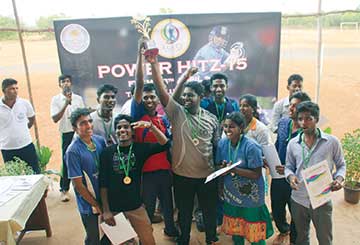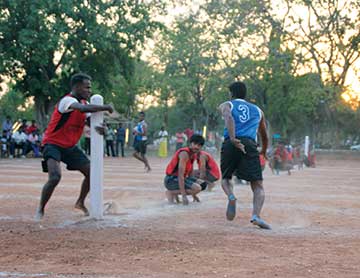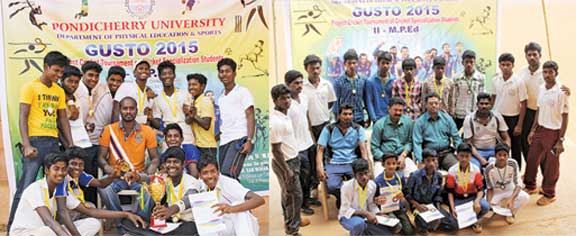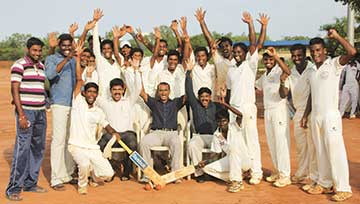R. Ram Mohan Singh
“If not us, who? If not now, when?” – John F Kennedy
- Can we say that Indian sports and sportspersons have been living up to our expectations so far?
- Apart from the commercial success of a few games like cricket, can we call our nation a force to reckon with at least in the Asian sports arena?
Surely, even the most optimistic person will doubt such a claim. We often compare the size of our population with our sports achievements, but is it practical and fair to do so?
 Let us imagine our entire population as a land resource that is cultivable. Only after cultivating as much land as possible, can we arrive at some conclusion about the fertility of the land and know what can be cultivated at which place and get the inputs required to give us the best yield. On the same lines, how many seeds have we actually sown in school for sports to yield us Olympic and international glory? What is the proportion of our students engaged in sports and physical activities when compared to their complete population? How much have we progressed in that direction? How can we expect a bumper harvest when we have hardly sown the right number of seeds?
Let us imagine our entire population as a land resource that is cultivable. Only after cultivating as much land as possible, can we arrive at some conclusion about the fertility of the land and know what can be cultivated at which place and get the inputs required to give us the best yield. On the same lines, how many seeds have we actually sown in school for sports to yield us Olympic and international glory? What is the proportion of our students engaged in sports and physical activities when compared to their complete population? How much have we progressed in that direction? How can we expect a bumper harvest when we have hardly sown the right number of seeds?
Champions are not made just by sitting in cozy drawing rooms and just wishing for excellence.
Just as the quality and growth of a building depends on the strength of its foundation, the sports base that we create for our sportspersons will eventually determine how far they can progress and win laurels at international sports events.
Now, let us identify the best possible place where the foundation can be laid. Yes, it starts at the school level, and hence, let us analyze how sports activities exist at the most critical level and work on how they can be improved to obtain the desired results.
The grim report
Apart from a few schools in the metropolitan cities, how much importance is given by schools in general to regular and systematic training of promising young sportspersons? If at all any such schools exist, the number will be negligible. Whatever little encouragement these schools offer, it may be largely directed to inter-school competitions and once these are over, it is back to classrooms and tuitions. Even for the inter-school competitions only a minimum possible time is allotted for training, and in some cases the time allotment is just for the record.
Is it very difficult for schools to understand that regular and systematic training in sports is just as important for a better performance in academics and subsequently in life as well? Ignoring these aspects, most schools, which are the prime places where foundations are laid, have converted sports into a stop-gap activity thereby giving it the least importance. This fact has also seeped into the minds of young sportspersons causing them to relegate sports to a negligible position or causing them even to give up their sports dreams. If this is the situation in schools that have a reasonably positive outlook towards sports, one can imagine what the
situation would be in the vast number of schools that do not even have a playground. The school authorities are only too happy to put sports on the backburner citing lack of infrastructure which they must actually possess in order to run the school.
The ratio of active participation in the inter-school sports activities is roughly about 25 per cent. This has resulted in the pooling of sportspersons in a select but small number of schools. This type of focus has encouraged serious deficiencies, such as needless hype, favoritism, and may even be the cause of several psychological issues.
 All such factors indirectly play a critical role in pulling down India’s chances of excelling in international sports. But the key challenge is to overcome our attitude of treating sports just as a stop-gap arrangement and conducting school sports events as a token activity rather than with the real intent to produce champion sportspersons.
All such factors indirectly play a critical role in pulling down India’s chances of excelling in international sports. But the key challenge is to overcome our attitude of treating sports just as a stop-gap arrangement and conducting school sports events as a token activity rather than with the real intent to produce champion sportspersons.
Setting up of long-term regular and systematic training at the school level will bring about the much required change in pushing up India’s ambitions towards excellence in global sports. Good quality at the foundation level will ensure excellent quality at the highest level. It is time we start working towards this objective.
Other significant issues include parents with negative attitude towards their child’s sporting ambitions, the politics prevalent in our sports bodies, corruption and favouritism. Though these issues may be beyond the control of a sportsperson or a supportive institution, the efforts of an individual and the institution will certainly fetch the rewards sooner or later by focusing on the right areas.
Participation of schools in a wide range of sports activities must be mandatory in order to have a good sports base on which talent can develop, even if the schools do not have reasonable infrastructure to support such ventures. It would certainly benefit if they can focus on training and development in one or two selected sports activities on a regular basis. This would certainly help in creating a strong and effective foundation for sports development from the school level. Further, engaging most, if not all, students in regular physical activity directly or indirectly connected with sports, can be a great idea to motivate more children to engage in physical exercises, get fitter and progress into high performance sportspersons in the future. Engaging in general physical activities at an early age is just as critical as regular training for a sportsperson in the later stages.
If schools are keen on improving their sports activities, but do not possess any infrastructure facilities, they can have some sort of agreement with a nearby school or an institution that has one. This would in fact benefit both the institutions, such as, sharing sports related expenses, organizing friendly matches and introducing competitive training and so on. But this requires sincere intent from the schools concerned in the larger interest of Indian sports as this is where the basic building blocks of Indian sports are formed. Our government and sports bodies will be able to see tangible results in a reasonable period of time if they strive to improve the quality of sports activities at the grassroots level and work upwards instead of expecting sudden world class performances. The performance of sportspersons will naturally be better when they are bred on a stronger foundation. In fact, improving quality at the formative stage would be much easier than pushing for change at an advanced level.
We have five-year plans to manage our economic progress. It would be equally justified if there be a five-year plan for the development and management of sports too. Only then can we find some positive relationship between our population and our sports achievements in the international arena. It is high time we push the right buttons to change the present sports scenario.

Role of parents
We see today that more and more relationships are maintained at a cost. Cost, which here means some material gain or loss that has accrued or what can be gained in the future, seems to be the essence of maintaining a relationship rather than the nature and value of the relationship itself. Even in this background, the most influential relationship in encouraging or discouraging a child to take up a sport rests with the parents. Hence, for creating a strong base which is instrumental in making a champion, the role of parents becomes absolutely critical.
We see many parents taking a lot of pain in escorting their children to a sports coach or a sports ground, and yet do not taste the success they desire. What could be the reason for it? How can it be overcome? Another major question is, how many such parents who are performing this routine see an Olympic or World champion in their child? There are also many parents who vehemently discourage sports activities for their children. A change in this attitude can make a huge difference to the Indian sports dream.
There is often a lot of debate that sport as a career does not have a future that is as bright and secure as some of the other fields. Perhaps in India this could have been true until a few years ago, but still the critical element for parents to understand here is that encouraging their children to take up sports need not necessarily mean making a career out of it. Playing is such a natural activity for any healthy child and as responsible parents they have to see to it that he or she is able to play some sport regularly and not discourage them. The basic motor abilities – speed, strength, endurance, agility and coordinative abilities – along with general physical wellbeing can be developed only by actively participating in physical activities and sports. With many professional national leagues being started nowadays, sports as a career is a very viable option, not just as a performing sportsperson but also as an allied technical support staff.
These days there are parents who are pushing their children to play just because they are overweight. What needs to be emphasized here is that once a child learns to walk, he or she is naturally drawn towards play and physical activity. Parents should encourage such ctivity and not see it as a waste of time. It must be stressed that regular playing time is essential for a child to maximize his or her natural growth and development and it need not necessarily be for a career.
 Parents need to understand that just as everyone going to school or college cannot secure a first rank, not everyone who plays sports can become a champion sportsperson. As children grow, they develop their own interests, which in many cases, in India, is forced on them. But being physically active especially by playing some sport at any level will not only help in the overall well-being of the person, it will also significantly raise the bar for people keen on making sports a career.
Parents need to understand that just as everyone going to school or college cannot secure a first rank, not everyone who plays sports can become a champion sportsperson. As children grow, they develop their own interests, which in many cases, in India, is forced on them. But being physically active especially by playing some sport at any level will not only help in the overall well-being of the person, it will also significantly raise the bar for people keen on making sports a career.
Now, let’s move on to the other critical element which is the ‘over enthusiasm’ of some parents. Let’s see how this element affects a young sportsperson’s performance and mindset. On many occasions, we see that parents force their will on their children and do not allow them to think and decide for themselves. Is this fair on the child? Parents should create and provide opportunities that will make their children think and take decisions on their own rather than the parents taking decisions for them, if they want to bring out the best in their children. Further, it’s better for the parents to leave the training part to a qualified professional coach rather than take up that critical job themselves. It will save them time and energy. My suggestion for parents is to let their child develop in a professional environment. It will be better for parents to keep their emotions under control during their child’s training or match. Encouraging good performance is fine, but there are parents who are constantly gesturing to their child on what they think he/she must be doing due to which the child’s focus and responses are diverted.
There is a fine line between how far a parent can influence their children’s thoughts and when to encourage them to take independent decisions. More often than not, we find that either there is too much influence or there is nothing at all. Sometimes it is the convenience of the parent that decides the involvement when it should actually be the other way round.
When the child reaches the level of realizing his/her potential, the parents can sit with their child and know what to expect from the sport. It will not only reinforce the confidence but will also help the parents understand their child’s ambitions better. It will also give the parents a fair idea about how their expectations can be matched to those of their child.
 The initiation of any child into taking up sports as a regular activity wholly depends on the parents and their involvement. Parents must realize that spending two hours a day on a sport does not have any serious impact on their child’s academic performance though it’s a fashion these days to simply link sports participation to any failure in academics. In fact, by actively participating in sports, the child is exposed to physical activity that is good for the body and spirit. There are quite a few examples of children having followed their illustrious parents, and have treated them as heroes and role models for their successful careers. Some of them are Ramanathan Krishnan and Ramesh Krishnan, Sunil Gavaskar and Rohan Gavaskar, Krishnamachri Srikkanth and Anirudha Srikkanth, Vece Paes and Leander Paes, Yogaraj Singh and Yuvraj Singh to name a few. Some of the parents have also become coaches for their children like R.D.Williams, father of Venus and Serena Williams.
The initiation of any child into taking up sports as a regular activity wholly depends on the parents and their involvement. Parents must realize that spending two hours a day on a sport does not have any serious impact on their child’s academic performance though it’s a fashion these days to simply link sports participation to any failure in academics. In fact, by actively participating in sports, the child is exposed to physical activity that is good for the body and spirit. There are quite a few examples of children having followed their illustrious parents, and have treated them as heroes and role models for their successful careers. Some of them are Ramanathan Krishnan and Ramesh Krishnan, Sunil Gavaskar and Rohan Gavaskar, Krishnamachri Srikkanth and Anirudha Srikkanth, Vece Paes and Leander Paes, Yogaraj Singh and Yuvraj Singh to name a few. Some of the parents have also become coaches for their children like R.D.Williams, father of Venus and Serena Williams.
Hence, to conclude, at the initial stage, the child can take part in a wide range of physical activities or sports, especially pure sports like athletics, gymnastics, swimming, etc, as they have greater emphasis on motor abilities than specific skills. As the child grows, he/she develops focus and interest in one or two specific sports. When the child reaches such a stage, he/she can be initiated into specific coaching. Thereafter, the role of the parents is that of a facilitator, unless they are professionally qualified to train. As the child matures, parents need to understand their child’s ambitions, and match theirs to that of their child or at least arrive at some common ground. Parents can then leave the coaching part to a professional coach for better and effective improvement in the child’s sporting career. The parents need to accept whatever level their child reaches and encourage him/her to enjoy sports participation rather than pressurizing them with their choices. By continuous encouragement and exposure every child can contribute towards building not only a strong nation but also towards nurturing their aspirations for success in their chosen arena which may or may not include Olympic dreams.
The author is Assistant Professor, Dept of Physical Education and Sports, Pondicherry University, Puducherry – a qualified NIS and NCA level-1 cricket coach and a qualified cricket umpire with teaching and coaching experience of about 20 years. He can be reached at dr.rammohansingh@gmail.com.
